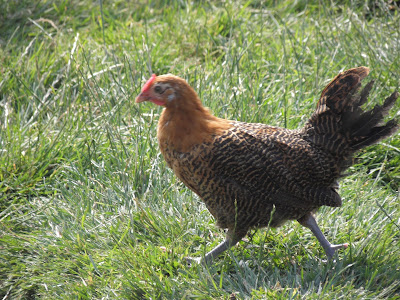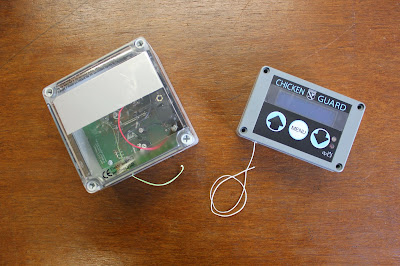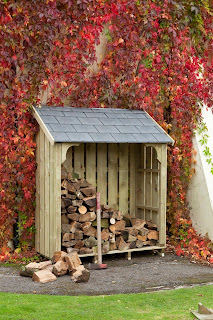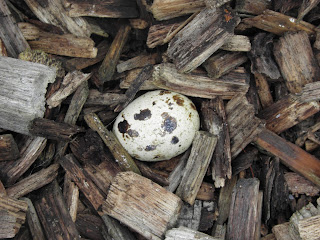While the year was perhaps this year more sunshine than rain, it has been a busy, exciting and at times frenetic year; what with Shows to attend, a new revolutionary Hen House to launch, news products to test and at all times, the stars of this blog, the FSF flock to look after.
 It was in March that we launched out latest hen house, the Aviary. With its unique one sided access design, it was created for poultry keepers with limited space in their gardens. Built to house a minimum of four birds in the smallest model, to a maximum eight in the largest, the hen house has many great features often requested by our customers. The house is raised off the floor, creating a sheltered area beneath, a dry place in winter for your birds or their feeders and drinkers, or a shady spot in the summer to keep cool. Secondly, with its large access door to both house and run, getting in to clean is easier than ever, incredibly useful during red mite season. Finally, it has a veranda of day perches out the front, perfect for an afternoon snooze for your girls. With the Aviary hen house successfully launched, the Royal Hampton Court Show and Tatton Park Shows loomed.
It was in March that we launched out latest hen house, the Aviary. With its unique one sided access design, it was created for poultry keepers with limited space in their gardens. Built to house a minimum of four birds in the smallest model, to a maximum eight in the largest, the hen house has many great features often requested by our customers. The house is raised off the floor, creating a sheltered area beneath, a dry place in winter for your birds or their feeders and drinkers, or a shady spot in the summer to keep cool. Secondly, with its large access door to both house and run, getting in to clean is easier than ever, incredibly useful during red mite season. Finally, it has a veranda of day perches out the front, perfect for an afternoon snooze for your girls. With the Aviary hen house successfully launched, the Royal Hampton Court Show and Tatton Park Shows loomed.This year we worked in conjunction with Country Living magazine and the Royal Horticultural Society, to bring something truly special to the Royal Hampton Court and Tatton Park Shows. Our celebrity designed Hobby Hen Houses. One of our most popular houses, in no small art due to its Alpine chalet looks, the Hobby Hen Houses were sent off to their respective celebrities and I returned to my chair to twiddle my thumbs and await the results. The six celebrities were BHWT supporters Phillipa Forrester, Kate Humble, Strictly star and Dragon's Den Deborah Meaden, gardeners gardener David Domoney, designer Sophie Conran and florist Nikki Tibbles. The arrival of the hen houses at the Royal Hampton Court Palace Show exceeded even my wildest dream, with each celebrity bringing their own unique touches or artistic flair; from Kate Humbles veg window boxes, Nikki Tibbles flowery affair or Deborah Meaden's Dragon's Chicken Den. The reception of the hen houses by all and sundry was unprecedented and really affirmed what it is we believe in here at FSF HQ. After they were displayed at Tatton Park to equal acclaim, they were auctioned off to raise money for two charities; the RHS School Garden Scheme and Country Living's choice of the Addington Fund, raising well over £2000.00 for these worthy charities.
 As the year passed we got many new and exciting products into FSF HQ, all needed to be given a trial run by our resident poultry scientists, the FSF Flock. From the new highly functional Automatic Door Openers, the ChickenGuard. With a built in timer and override open and close buttons, the ChickenGuard has proven incredibly popular with our customers. Over the Summer, as the sun beat down, we test drove the new Trent Drinker, in our chicken paddock. A sturdy plastic fountain drinker, it is modelled to work in a similar way as a galvanised fountain drinker and its ease of use. certainly made keeping the flock well supplied with water an easy task. As winter rose its weary and sleepy head over the landscape, Nature's Grub arrived with some tasty new Garden Blends, each filled with nutritious and delicious yummy-ness it did not take long for our hens to eat them up.
As the year passed we got many new and exciting products into FSF HQ, all needed to be given a trial run by our resident poultry scientists, the FSF Flock. From the new highly functional Automatic Door Openers, the ChickenGuard. With a built in timer and override open and close buttons, the ChickenGuard has proven incredibly popular with our customers. Over the Summer, as the sun beat down, we test drove the new Trent Drinker, in our chicken paddock. A sturdy plastic fountain drinker, it is modelled to work in a similar way as a galvanised fountain drinker and its ease of use. certainly made keeping the flock well supplied with water an easy task. As winter rose its weary and sleepy head over the landscape, Nature's Grub arrived with some tasty new Garden Blends, each filled with nutritious and delicious yummy-ness it did not take long for our hens to eat them up.While everything else was going on this year, of course there was our Flyte so Fancy flock to take care of. 2013 saw new arrivals, some gorgeous Gold Sebright's and Quail who now live in an Aviary 8 and Maggie's Dozen by the FSF Shop. Down in the chicken paddock, two clutches of Silver Spangled Hambugs and one of Gold Laced Hamburgs successfully hatched and the year also saw a gosling or two join our gaggle of geese. Most recently a pair of Old English Pheasant Fowl came to live with us in our chicken paddock.
As the winter chill begins to spread through the bones, icy breaths fog the air and our sister company Dorset Log Stores finds herself gearing up to keep people warm, here at FSF in the last week before Christmas we've begun our annual tidy, made sure that there is a deeper layer of Hemp-E bedding in all the coops and personally beginning to prepare for another busy year of blogs all about chicken news, tips and ideas and what is going on here in the heart of Dorset, at Flyte so Fancy.



















































